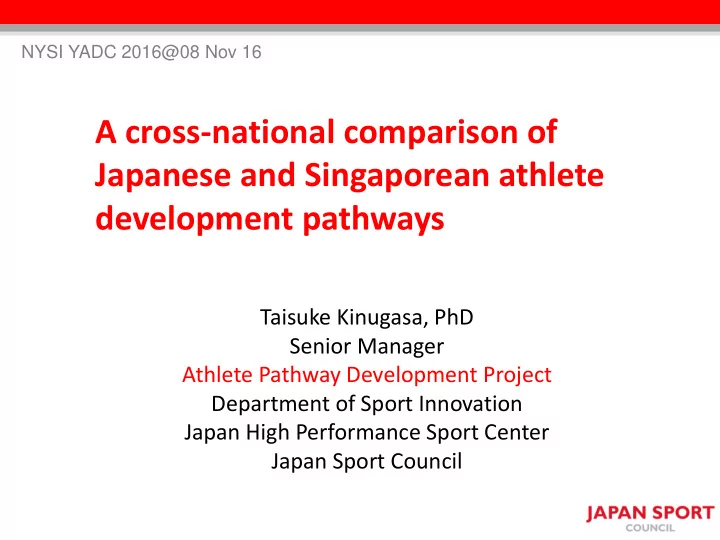

NYSI YADC 2016@08 Nov 16 A cross-national comparison of Japanese and Singaporean athlete development pathways Taisuke Kinugasa, PhD Senior Manager Athlete Pathway Development Project Department of Sport Innovation Japan High Performance Sport Center Japan Sport Council
Athlete Pathways in Singapore
Start with a dream Dr Chester Hill UCI & British Cycling
Source: www.calciomatome.net
Growth of TID/Pathway Initiatives in Japan Olympic and Paralympic Integrated NTID (2016) Athlete Pathway Development Project Para-pathway (2012, 2013) study group Kochi TID NTID kick off RTID kick off (2015) (2009) (2012) (2014) World-class Pathway Network kick off (2015) Kagawa TID Sport Basic Plan (2009) (2012) Akita TID Post 2020?? Basic Act on Sport (2009) (2011) Hokkaido TID Nagano TID Kyoto TID (2014) (2009) (2011) Miyagi TID Kamikawa TID Saitama TID (2013) 2013 - (2009) NTC opened (2011) Yamaguchi TID (2008) (2009) Yamagata TID Invited presentation at World Tokyo TID (2007) LTAD Symposium (2009) Wakayama TID 2009 - (CAN) (2014) (2006) Iwate TID Invited presentation at Talent (2007) 2012 Bifuka TID Identification Conference JISS opened (2005) (QAT) (2014) A combined TID (2001) Fukuoka TID 2005 - programme with (2004) Basic Plan for the KOR (2010) Promotion of Sports 2008 (2000) Rugby Invited JSC and Fukuoka Hirao Project 2000 - staff at Singapore (1996) Sports School (SIN) 2004 (2009) Invitation of AIS TID coordinators to Fukuoka (2004)
Medal Potential Athletes x Medal Success Rates USA 200 (29%) 193 (38%) - CHN 162 (35%) 158 (41%) - GBR 109 (32%) 114 (36%) - JPN 71 (20%) 84 (32%) 80 (33%) Source: JSC Department of Information & International Relations
Current system New performance pathway Milestones World top 8 Top athletes World top 16 Senior national team/athletes Potential athletes YOG & Junior World Champ athletes Age group athletes National age-group athletes Regional age-group athletes Children in regions Sports participants
Where are Talents? (World-class Pathway Network) Bifuka (2005) Transfer sports Hokkaido (2014) (aerial skiing) ◎ Target sports ◎ A category (Curling, skeleton, biathlon) Hokkaido (16 locals) ◎ region B category Akita (2009) Kamikawa (2009) (8 locals) Target sports Target sports (Fencing, shooting, speed skating) (5 winter sports) Yamagata (2009) Iwate (2007) Multi-sports Multi-/Target sports (5 sports) Yamaguchi (2009) ◎ ◎ Tohoku Miyagi (2013) Gifu (2015) Nagano (2009) Target sports Multi-sports Multi-sports Target sports (Wrestling, sailing, fencing) region (10 winter sports) ◎ ◎ Tochigi (2016) Kyoto (2011) Multi-sports Target sports (Fencing, badminton, canoe) Saitama (2011) Multi-sports ◎ ◎ Kagawa (2009) Fukuoka (2004) Multi-sports ◎ Tokyo (2009) Multi-sports ◎ ◎ Transfer sports (7 sports) ◎ ◎ Saga ◎ (In preparation) ◎ Mishima-city ◎ ◎ Mie (2016) (2015) ◎ Target sports ◎ ◎ Multi-sports Oita (2015) ◎ ◎ Target sports Wakayama (2006) (6 sports) Kyushu Multi-sports Kochi (2009) region ◎ Multi-sports Miyazaki (2015) Multi-sports Ehime (2015) Multi-sports
Japan High Performance Sport Center at Nishigaoka Japan Institute of Sports Sciences (JISS) AJINOMOTO National Training Center (NTC)
Deliberate practice of JPN YOG athletes 35.0 30.0 YOG medalists 25.0 (Hours per week) Training volume YOG participants 20.0 15.0 10.0 5.0 0.0 Childhood Early Mid Late Early Adulthood adolescence adolescence adolescence adulthood JOC study: Kinugasa and Hirose, (2014)
Entourage of JPN YOG athletes JOC study: Kinugasa and Hirose (2014)
Pathway Trajectories of Japanese Athletes → JSC Dual Career Survey (2014) analyzed data of 263 Olympians Non-linear Linear Pure ascent Mixed ascent Mixed descent N 43 98 122 % 15.3% 34.9% 43.4% Trajectory
Target Team JAPAN The outreach strategy • Limited knowledge sharing A and education Commit B The support strategy • Little info on daily training C environment • Little use of SSSM • Balancing sports, study, and Desire career • Coaches seeking quick results The promotion strategy • Limited local training venues • Quality of programmes • Early exposure to overseas • Governance of NFs The entry strategy • Declining birthrate, polarization, monopoly • Limited opportunity to transfer
Talent Supply Chain Chance Over-supply Environment Individual Exit Promotion factors strategy “ ” supply chain (The high road?) Distractions Entry Under-supply Individual Environment strategy
Performer Environment Relative age effect Birthplace effect Genetic profiles Entourage (eg parents, Physical and family and coaches) physiological Athlete support (eg jr Psychological and to senior conversion) personality Practice and training Deliberate practice (eg 10,000 hr rule) Early vs late specialization
A Strong and Sustainable System 1. Coach 2. Environment 3. Talent (Athlete)
Local x JSC x NSAs = Japanese Athlete Pathway Co-design 協働
Olympic and Paralympic Integrated National TID Programme
Where there’s WILL, there’s a PATHWAY
Raise The Future With The Power of Sport
Recommend
More recommend